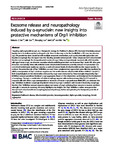Exosome release and neuropathology induced by α-synuclein: new insights into protective mechanisms of Drp1 inhibition
| dc.contributor.author | Fan, RZ | |
| dc.contributor.author | Guo, M | |
| dc.contributor.author | Luo, Shouqing | |
| dc.contributor.author | Cui, M | |
| dc.contributor.author | Tieu, Kim | |
| dc.date.accessioned | 2021-10-22T12:44:16Z | |
| dc.date.issued | 2019-11-19 | |
| dc.identifier.issn | 2051-5960 | |
| dc.identifier.issn | 2051-5960 | |
| dc.identifier.other | 184 | |
| dc.identifier.uri | http://hdl.handle.net/10026.1/18158 | |
| dc.description.abstract |
<jats:title>Abstract</jats:title><jats:p>Targeting alpha-synuclein (α-syn) as a therapeutic strategy for Parkinson’s disease (PD) has been intensively pursued largely due to its well-recognized pathogenic role. Since its discovery as the first familial link to PD over two decades ago, this protein has been associated with multiple neurotoxic mechanisms, such as mitochondrial dysfunction and impaired autophagic flux. We report here that blocking dynamin-related protein 1 (Drp1) improved both mitochondrial function and autophagic flux in experimental models of α-syn. Using rat dopaminergic neuronal cells with inducible wild-type human α-syn, we observed excessive mitochondrial fragmentation and increased Drp1 levels 48 h after gene induction. Functionally, these cells exhibited lower mitochondrial membrane potential, reduced ATP production rate and mitochondrial spare respiratory capacity, as well as increased levels of mitochondrial reactive oxygen species. To evaluate the protective role of Drp1 inhibition, we used three complementary approaches: gene silencing mediated by siRNA, overexpression of Drp1-dominant negative and the small molecule mitochondrial division inhibitor-1 (mdivi-1). Both morphological and functional defects induced by α-syn were attenuated by these strategies. Importantly, Drp1 inhibition reduced proteinase K-resistant α-syn aggregates. Based on that observation, we investigated the involvement of autophagy. Through a combination of stable autophagy reporter cells and immunoreactivity for LC3 and p62 in neuronal cells with either α-syn overexpression or treatment of human α-syn preformed fibrils (PFF), we observed that Drp1 inhibition abolished autophagic impairment induced by α-syn. Consistent with its role in improving autophagy function, Drp1 inhibition reduced exosome release and spread of α-syn pathology from neurons to neurons and from microglia to neurons. In summary, this study highlights new insights that Drp1 inhibition confers neuroprotection through both mitochondrial and autophagy-lysosomal pathways, further strengthening the therapeutic potential of targeting Drp1.</jats:p> | |
| dc.format.extent | 184- | |
| dc.format.medium | Electronic | |
| dc.language | en | |
| dc.language.iso | en | |
| dc.publisher | BioMed Central | |
| dc.subject | Parkinson's disease | |
| dc.subject | Mitochondrial dynamics | |
| dc.subject | Neurodegeneration | |
| dc.subject | Alpha-synuclein | |
| dc.subject | Autophagy | |
| dc.subject | Protein aggregation | |
| dc.title | Exosome release and neuropathology induced by α-synuclein: new insights into protective mechanisms of Drp1 inhibition | |
| dc.type | journal-article | |
| dc.type | Journal Article | |
| dc.type | Research Support, N.I.H., Extramural | |
| dc.type | Research Support, Non-U.S. Gov't | |
| plymouth.author-url | https://www.webofscience.com/api/gateway?GWVersion=2&SrcApp=PARTNER_APP&SrcAuth=LinksAMR&KeyUT=WOS:000509586300001&DestLinkType=FullRecord&DestApp=ALL_WOS&UsrCustomerID=11bb513d99f797142bcfeffcc58ea008 | |
| plymouth.issue | 1 | |
| plymouth.volume | 7 | |
| plymouth.publication-status | Published | |
| plymouth.journal | Acta Neuropathologica Communications | |
| dc.identifier.doi | 10.1186/s40478-019-0821-4 | |
| plymouth.organisational-group | /Plymouth | |
| plymouth.organisational-group | /Plymouth/Faculty of Health | |
| plymouth.organisational-group | /Plymouth/Faculty of Health/Peninsula Medical School | |
| plymouth.organisational-group | /Plymouth/REF 2021 Researchers by UoA | |
| plymouth.organisational-group | /Plymouth/REF 2021 Researchers by UoA/UoA01 Clinical Medicine | |
| plymouth.organisational-group | /Plymouth/REF 2021 Researchers by UoA/UoA01 Clinical Medicine/UoA01 Clinical Medicine | |
| plymouth.organisational-group | /Plymouth/Research Groups | |
| plymouth.organisational-group | /Plymouth/Research Groups/Institute of Translational and Stratified Medicine (ITSMED) | |
| plymouth.organisational-group | /Plymouth/Research Groups/Institute of Translational and Stratified Medicine (ITSMED)/CBR | |
| plymouth.organisational-group | /Plymouth/Users by role | |
| plymouth.organisational-group | /Plymouth/Users by role/Academics | |
| plymouth.organisational-group | /Plymouth/Users by role/Researchers in ResearchFish submission | |
| dc.publisher.place | England | |
| dcterms.dateAccepted | 2019-09-29 | |
| dc.rights.embargodate | 2021-10-23 | |
| dc.identifier.eissn | 2051-5960 | |
| dc.rights.embargoperiod | Not known | |
| rioxxterms.versionofrecord | 10.1186/s40478-019-0821-4 | |
| rioxxterms.licenseref.uri | http://www.rioxx.net/licenses/all-rights-reserved | |
| rioxxterms.licenseref.startdate | 2019-11-19 | |
| rioxxterms.type | Journal Article/Review | |
| plymouth.funder | Tackling autophagy and apoptosis for the potential therapy of Huntington's Disease::MRC | |
| plymouth.funder | Tackling autophagy and apoptosis for the potential therapy of Huntington's Disease::MRC |


